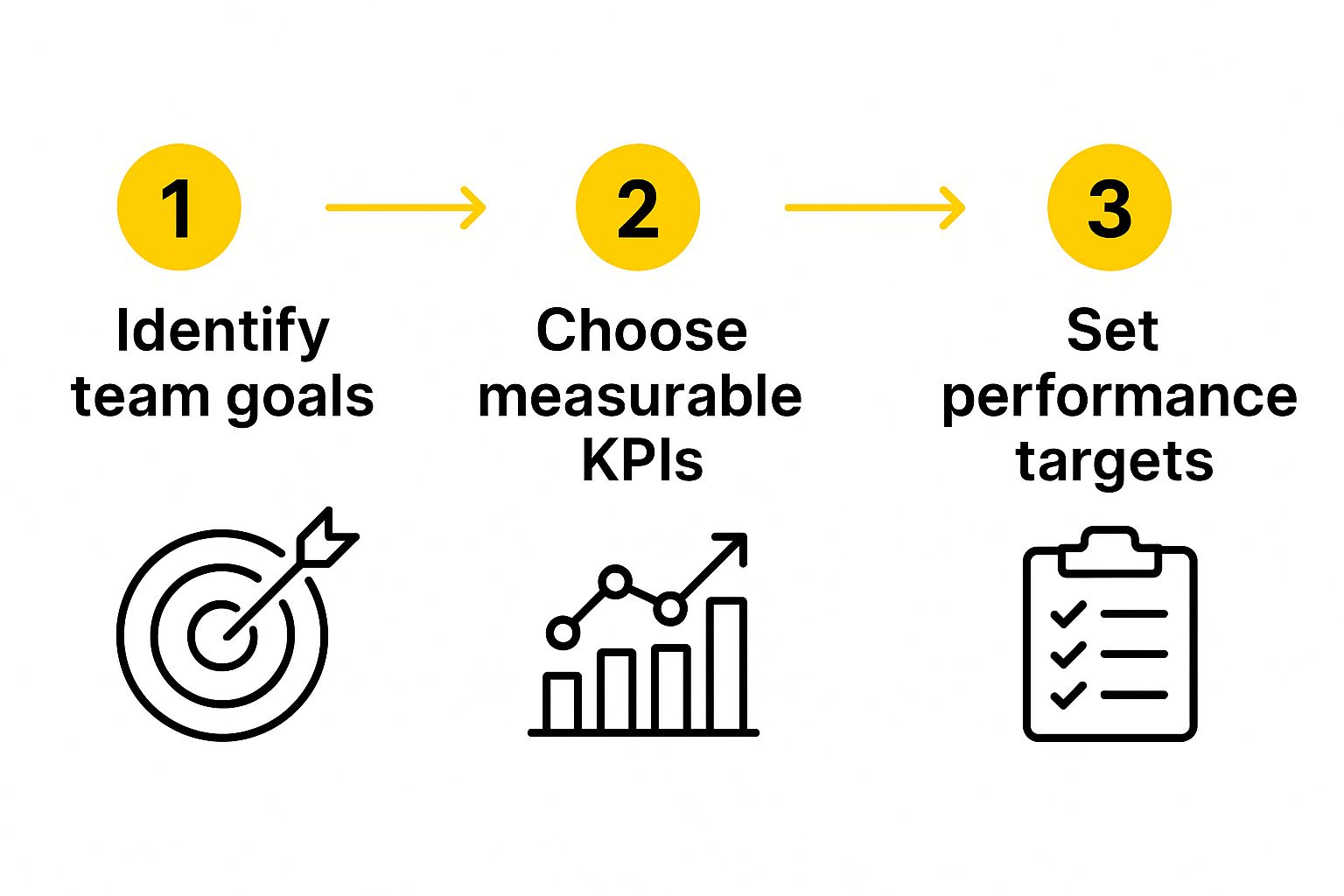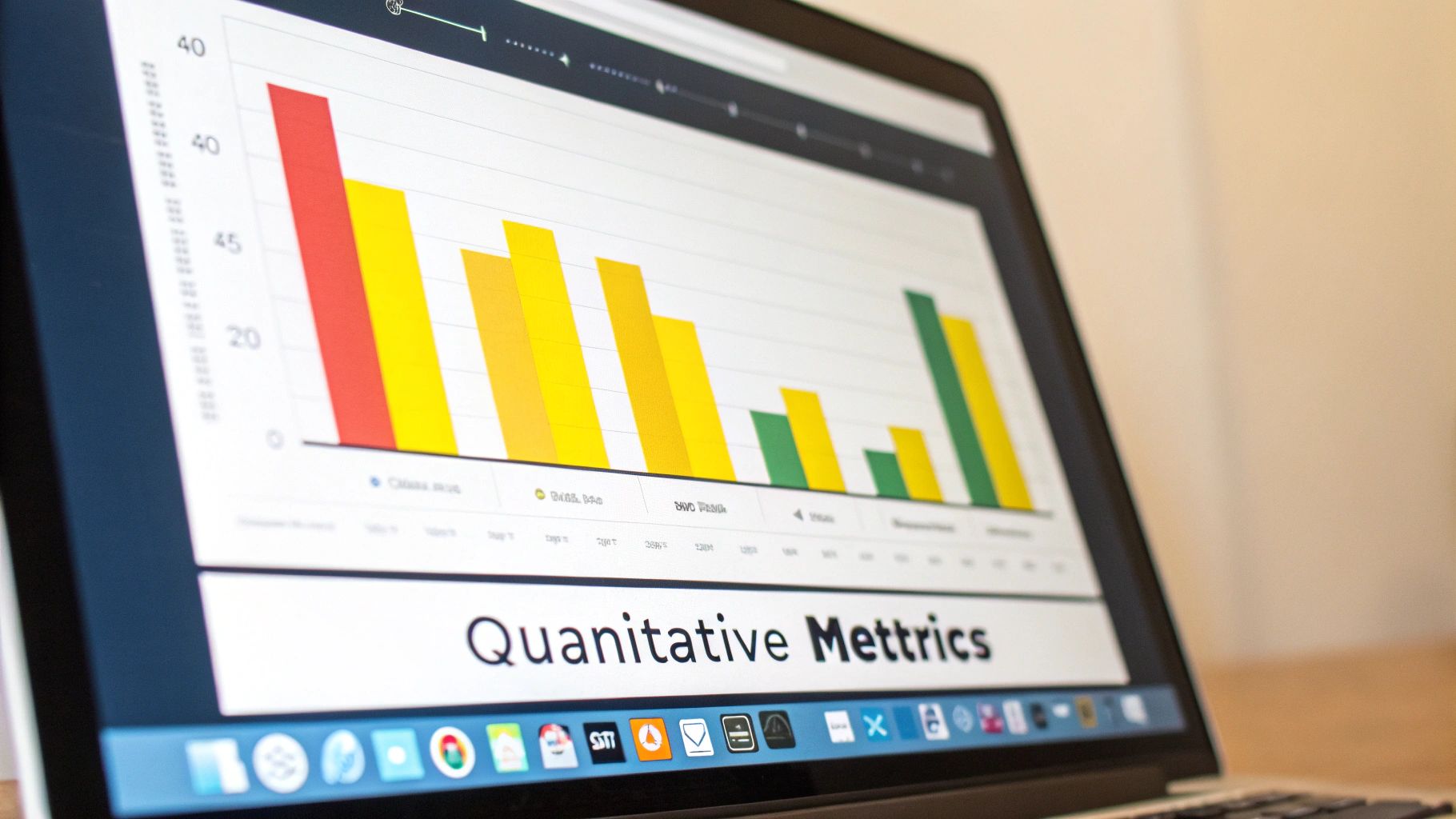Let’s get one thing straight: measuring team performance today has nothing to do with the dreaded annual review. It’s about building a continuous, data-informed system that actually helps people grow. The goal is to blend hard numbers with real, human feedback to get a complete picture of your team’s health, engagement, and how well you’re all pulling in the same direction.
Why Traditional Performance Reviews Are Obsolete

The annual performance review is a relic. For decades, it was the default way to evaluate people, but in today’s world of fast-paced, collaborative work, it just doesn’t cut it anymore. A once-a-year meeting packed with retrospective judgment rarely gives teams the timely insights they need to actually improve.
Think about it. Modern work is agile. Teams are often spread out across the globe, and goals can shift every quarter. Waiting 12 months to have a performance conversation is like trying to navigate a winding road by only looking in the rearview mirror. It’s a fundamentally broken model.
The Disconnect Between Reviews and Reality
The core problem is a painful misalignment with how work actually gets done. Old-school reviews fixate on individual achievements, often completely missing the collaborative magic that drives the best results. This can create a culture of competition where you desperately need teamwork.
And the data doesn’t lie. A massive 74% of workers in the U.K. find traditional appraisals useless, which shows a huge gap between what these reviews are supposed to do and what they actually accomplish. It’s no wonder global employee engagement hovers between a dismal 21% and 23%. When the main tool for feedback is broken, motivation and connection are the first casualties. You can dig into more on this topic with these performance management statistics.
The biggest flaw of the annual review is its timing. Feedback delivered months after something happens is stripped of its context and power. It’s nearly impossible for an employee to connect that advice to a specific action and make a real change.
Moving Toward a Better System
So, what’s the alternative? The future is a continuous, holistic approach to performance. It’s about creating a living, breathing system that’s built on real-time feedback, transparent data, and a clear, shared vision of success. This isn't about one high-stakes meeting; it's about an ongoing conversation.
To make this shift, you’ll need to focus on a few key things:
- Real-time Data: Use tools and lightweight processes to capture performance info as it happens, not months later.
- Qualitative Insights: Go beyond just output. Pay attention to feedback on collaboration, communication, and overall well-being.
- Team-Centric Goals: Rally everyone around shared objectives that define what success looks like for the entire team, not just individuals.
The difference between the old way and the new way is stark. The old model was a top-down, once-a-year judgment. The modern approach is a continuous loop of feedback and growth.
Traditional vs Modern Performance Measurement
| Attribute | Traditional Approach | Modern Approach |
|---|---|---|
| Frequency | Annual or semi-annual | Continuous, real-time |
| Focus | Individual accomplishments, past mistakes | Team collaboration, future growth, skill development |
| Data | Subjective manager ratings, recency bias | Quantitative metrics and qualitative feedback |
| Goal | Judgment and ranking | Development and alignment |
| Impact | Creates anxiety, demotivates, low engagement | Fosters trust, improves performance, boosts engagement |
Ultimately, moving to a modern system isn't just about changing a process. It’s about changing the conversation from "How did you do?" to "How can we help you succeed?" This fundamental shift is what unlocks true team potential.
Defining Success Metrics That Actually Matter
Before you can even think about measuring team performance, everyone has to agree on what "success" actually looks like. It’s a simple truth that gets missed all the time. Trying to track progress without a shared definition of "good" is like setting out on a road trip with no destination. You're definitely moving, but who knows if you're getting any closer to where you need to be.
The trick is to ditch the generic vanity metrics and zero in on indicators that truly reflect your team’s purpose and how it contributes to the bigger company goals. This isn't a top-down order; it has to be a collaborative process. I've found that the most powerful metrics are the ones co-created with the team. It builds ownership from day one. When your team helps set the targets, they are far more invested in hitting them.
This process visualizes how identifying team goals naturally leads to choosing measurable KPIs and setting specific performance targets.

The flow here is simple but critical: metrics should never feel arbitrary. They must always be a direct result of your team's strategic objectives.
Creating a Balanced Scorecard
A classic mistake is getting hyper-focused on one type of metric, usually productivity. Think about it. A software team that only measures lines of code might churn out features fast, but they could be riddled with bugs. A support team judged only on ticket volume might rush customers off the phone, tanking your satisfaction scores.
A balanced approach is absolutely essential. Your "scorecard" should pull in a mix of metrics covering different angles of performance. This gives you a holistic view and stops you from accidentally optimizing one area at the expense of another.
- Productivity & Efficiency: These are your output metrics. Think sprint velocity for an engineering team or leads generated for a marketing team. They answer the question: "Is the team delivering work effectively?"
- Quality & Effectiveness: These measure the impact of that work. Examples include bug-to-feature ratio, customer satisfaction (CSAT) scores, or campaign conversion rates. They tell you: "Is the work good?"
- Team Health & Well-being: This is the one everyone forgets, but it’s critical for long-term success. Metrics like employee Net Promoter Score (eNPS) or absenteeism rates can signal burnout or disengagement long before it completely derails performance. For more ideas in this area, you can explore these key continuous improvement metrics.
Real-World Examples in Action
Let's make this practical. Imagine you lead a customer support team. A balanced set of KPIs might look something like this:
- Productivity: Average First Response Time (under 60 minutes)
- Quality: Customer Satisfaction Score (90% or higher)
- Efficiency: Average Ticket Resolution Time (under 4 hours)
- Team Health: Team eNPS (score of +50 or higher)
See how these metrics create a healthy tension? Pushing for a faster response time is great, but not if your CSAT score plummets because the quality of the answers suffers. Tracking them together forces you to maintain a healthy equilibrium.
Pro Tip: Start small. It's so much better to track three to five meaningful metrics consistently than to get overwhelmed by a dozen that you can't properly analyze. You can always refine and expand your KPIs as the team matures.
When you take this kind of collaborative and balanced approach, performance measurement stops being a dreaded judgment and becomes a shared tool for growth. It empowers the team by giving them a clear, fair, and transparent way to see how their work contributes to the bigger picture.
Building a System for Continuous Data Collection

Once your success metrics are locked in, the next hurdle is actually gathering the data. The trick is to do it without turning your team's workflow into a bureaucratic slog. You want a system that makes performance tracking feel like a natural, almost invisible part of the daily routine—not just another chore to check off.
This approach marks a huge shift away from those dreaded, high-stress formal reviews. Instead, you're creating an ongoing, constructive conversation about performance. It’s all about generating a steady stream of objective information that builds trust and empowers the team to nip problems in the bud. For hybrid and remote teams who can't rely on office osmosis, modern tools and integrated processes are absolutely essential.
Integrating Data Collection into Daily Workflows
The best systems are the ones that pull data from tools your team is already using every single day. Forget about introducing a clunky new process. Instead, look for ways to tap into your existing touchpoints. This makes the whole thing feel organic rather than intrusive.
A fantastic starting point is your project management software. Tools like Jira, Asana, or Trello are absolute goldmines for performance data. Right out of the box, you can start tracking metrics like:
- Task Completion Rates: What's the ratio of completed tasks to assigned tasks within a sprint or week?
- Cycle Time: How long does it really take for a task to get from "in-progress" to "done"?
- Planned-to-Done Ratio: How does the work we actually shipped compare to what we planned to do?
These aren't just vanity metrics; they give you a real-time, quantitative pulse on productivity and workflow efficiency. They form the bedrock of understanding how work actually gets done on your team.
Leveraging Agile Ceremonies and Check-ins
It's not all about the tools, though. Your team's routine meetings are incredibly powerful opportunities for gathering data. Agile ceremonies, in particular, are practically designed for this kind of reflection and continuous improvement.
Think about it: a bi-weekly retrospective isn't just a venting session. It's a prime opportunity to collect qualitative data on roadblocks, collaboration snags, and overall team morale. In the same way, regular one-on-one check-ins create a safe space to dig into individual challenges and development goals, adding critical context to the bigger performance picture. To make these chats even more valuable, it's key to learn how to delegate tasks effectively so you can focus on coaching.
The real magic happens when feedback becomes continuous. Organizations that implement real-time feedback see huge boosts in productivity and are three times more likely to smash their business goals. A staggering 80% of employees actually prefer it over old-school annual reviews.
Creating a Real-Time Performance Dashboard
The final piece of the puzzle is to bring all this information together into one central, easy-to-access place. A real-time dashboard that visualizes your key metrics allows everyone—from individual contributors to leadership—to see how the team is tracking against its goals at a single glance.
This level of transparency is what truly fosters a data-driven culture. When everyone is looking at the same information, it depersonalizes performance conversations. The dialogue shifts from a vague, "You seem to be falling behind," to a collaborative, "It looks like our cycle time is creeping up. Let's figure out why together."
A centralized dashboard transforms data from a manager's private report card into a shared team resource for navigating obstacles and, just as importantly, celebrating wins.
Turning Performance Data Into Actionable Insights
Collecting performance data is only half the job. Honestly, it's the easy part. A dashboard full of raw numbers—cycle times, task completion rates, you name it—doesn't tell you much on its own. The real magic happens when you turn that data into a story that explains why things are happening. This is where you graduate from simply tracking metrics to truly understanding your team's rhythm and flow.
Looking at the numbers is really about spotting patterns. Is productivity always taking a nosedive on Thursdays? Did quality scores plummet right after you rolled out that new workflow? Answering these kinds of questions helps you find the hidden bottlenecks. It's the difference between seeing a symptom, like a cough, and diagnosing the actual illness.
Facilitating Constructive Performance Discussions
Once you’ve spotted a trend, it’s time to bring it to the team. But how you do this is critical. This can’t feel like an interrogation. It has to be a collaborative, blameless conversation focused on improving the system, not pointing fingers. The goal is to build psychological safety, where everyone feels comfortable enough to be honest.
One of the best tools I’ve ever come across for this is the After-Action Review (AAR). It’s a simple but incredibly powerful framework the U.S. Army uses to learn from missions, and it works wonders for agile teams.
The AAR framework brilliantly shifts the conversation from "who did what" to "what happened and why." This simple change is the key to creating a culture where data is a flashlight, not a hammer.
The AAR is built around four straightforward questions:
- What was supposed to happen? (What was our goal?)
- What actually happened? (What does the data show?)
- Why was there a difference? (Let's get to the root cause.)
- What can we learn from this? (How do we get better?)
This structure, often visualized in a simple table, provides a safe, organized way to dissect performance data. It transforms what could be a tense review into a productive problem-solving session.
From Insights to Concrete Actions
Here’s where the rubber meets the road. An insight without a follow-up action is just a nice idea that goes nowhere. After an AAR or any performance-focused chat, the team must walk away with clear, agreed-upon next steps.
These actions need to be specific and have an owner. For example, if you discovered a bottleneck in the code review process, an action item isn't "improve code reviews." It's: "Sarah will research and propose a new peer-review checklist by next Friday."
For anyone leading an agile team, mastering these practices is non-negotiable. If you're looking to go deeper, you can learn more about how to master agile team performance metrics for even better outcomes.
By consistently analyzing data, hosting blameless discussions, and creating concrete action plans, you build a powerful feedback loop. This is how you truly measure team performance—not just by staring at numbers, but by using them to fuel meaningful, continuous improvement.
Fostering a Culture of Engagement and Ownership

Here's the thing: how you measure your team's performance sends a loud and clear message about what your company really values. If the process feels secretive, judgmental, or completely detached from what people do every day, you’re just creating a recipe for disengagement.
But when you get it right, a transparent and fair measurement system becomes the bedrock of a high-performing team. It builds a culture on trust and a shared sense of purpose.
High-performing teams don't just magically appear. They are carefully cultivated in an environment of psychological safety, where data is used to help, not to punish. The real goal is to draw a straight line from each person's daily tasks to the team’s mission and the company's vision. That’s how you get genuine ownership.
Anything less is a silent productivity killer. Low employee engagement is a massive anchor dragging down your team's potential, creating an atmosphere where people do just enough to get by.
The Staggering Cost of Disengagement
Employee engagement is a direct reflection of how well your performance measurement system actually works. The numbers tell a pretty stark story. According to Gallup's 2025 State of the Global Workforce report, a mere 21% of employees worldwide feel engaged at work.
Just think about that untapped potential for a second. If global engagement could climb to an ambitious 70%, organizations could unlock an incredible US$9.6 trillion in added productivity. You can dive deeper into these findings in Gallup's full report.
This isn't some fluffy "nice-to-have" metric. It's a critical vital sign for your team’s health and its future.
Shifting from Judge to Coach
The manager's role is absolutely pivotal in making this cultural shift. When performance data is on the table, a manager has a choice: act like a judge delivering a verdict, or step in as a coach guiding development. The latter is where real, meaningful growth happens.
The key is using metrics to start good conversations. Instead of saying, "Your ticket resolution time is down," a coaching approach sounds more like, "I've noticed our team's average resolution time has ticked up. What roadblocks are you hitting, and how can I help clear them out?"
This simple change in framing transforms the entire dynamic. It turns a moment that could be confrontational into a collaborative problem-solving session. This builds trust and shows the performance system is there to support the team, not to catch them making mistakes.
A manager's primary role in performance measurement is to provide context and support. Data tells you the 'what,' but only a coaching conversation can uncover the 'why' and co-create the 'how' for improvement.
Practical Strategies for Fostering Ownership
Building this kind of culture takes deliberate, consistent action. It’s all about weaving engagement and ownership into the very fabric of your team's day-to-day operations.
- Celebrate Team Wins, Not Just Individual Stars: When you hit a major goal, make sure the celebration is about the collective effort. Point out how different people and roles contributed to that success.
- Link Daily Tasks to the Bigger Picture: Regularly connect the dots for your team. Show them how their work—whether it’s closing a support ticket or fixing a bug—directly impacts customer happiness and company goals.
- Give the Team Control: Let the team own their process improvements. When they use performance data to spot a bottleneck, empower them to design, test, and implement the solution themselves.
By putting these strategies into practice, you shift the focus from a top-down evaluation to a team-led improvement cycle. If you're hunting for more hands-on methods, our guide on how to improve team productivity offers other valuable techniques. This creates a powerful feedback loop where transparent measurement fuels engagement, and engaged employees drive outstanding performance.
Even after you’ve rolled out a solid framework for measuring performance, you’re bound to hit a few roadblocks. It’s only natural. Let’s walk through some of the most common questions and challenges that pop up, with clear, experience-based answers to help you steer clear of the pitfalls.
How Often Should I Review Team Performance Metrics?
For most teams I’ve worked with, hitting a weekly or bi-weekly rhythm during regular team meetings is the sweet spot. This keeps the data fresh and makes course corrections feel timely and natural, rather than turning the review into a massive, burdensome event. Big project milestones are also a perfect opportunity for a deeper dive.
The idea is to bake performance reviews into your team's routine. Think of it as a continuous, lightweight process. Daily stand-ups are great for squashing immediate blockers, but these more regular reviews are where you spot trends and track real progress. This approach stops the data from going stale and makes performance talks a normal part of the workflow, not some dreaded annual judgment day.
What Is the Difference Between Team and Individual Performance?
This is a crucial distinction. Team performance is all about the "we." It answers questions like, "Did we ship that feature on schedule?" or "Did our team’s velocity see an uptick this sprint?" The focus is squarely on collective achievements and shared goals.
Individual performance, on the other hand, zooms in on a person’s unique contributions, their skill development, and personal growth. A healthy system understands that team success is built on individual effort, but it never loses sight of the team's overall win. The most effective leaders I've seen are masters at connecting individual goals directly to team objectives, so everyone can see exactly how their work fuels the collective mission.
Transparency is the bridge between team and individual metrics. When everyone understands how their personal contributions drive collective success, the entire performance measurement process feels more empowering and less like a top-down judgment.
How Do You Measure Performance for Creative or Research Teams?
Ah, the classic question. For teams where the output isn't easily counted—like creative or R&D teams—you have to get, well, creative. The trick is to shift your focus from purely quantitative outputs to more qualitative indicators and milestone-based progress. You simply can't measure their impact by counting lines of code or articles published.
Instead, try tracking things like:
- The success rate of project proposals they’ve submitted.
- The documented impact of their research on the product roadmap.
- Feedback from peer reviews on creative concepts or designs.
- How well they’re progressing against an R&D roadmap.
When you blend these with practical metrics like sticking to project timelines and budgets, you get a much more balanced and fair picture. It’s not about measuring activity; it’s about measuring progress and impact. The real question is how the work moved the needle, not just how much work got done.
How Can I Implement This Without My Team Feeling Micromanaged?
This is probably the most important question of all. The answer boils down to one simple, powerful word: transparency. You have to introduce any measurement system as a tool for team improvement, not individual scrutiny.
Get the team involved from day one. Have them help co-create the KPIs. When people have a hand in choosing the metrics, they feel a sense of ownership over the process. Always frame discussions around system-level trends and team-wide challenges, not by calling out individuals. For instance, you could explore how you are measuring team morale right alongside productivity metrics.
When your team sees you using data to clear obstacles and celebrate wins together, they won't just tolerate it—they’ll embrace it as a powerful tool for everyone.
Transform your team meetings from status updates into strategic power sessions. With resolution Reichert Network Solutions GmbH, you can use NASA to facilitate structured, engaging, and action-oriented discussions. See how NASA can elevate your team’s performance.
